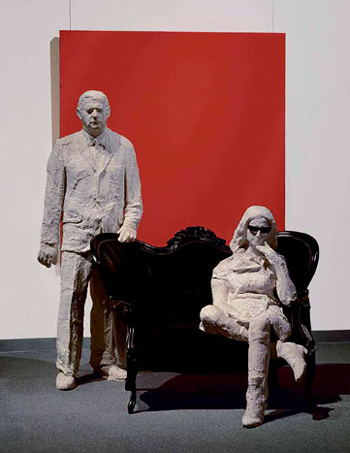Can and Should Artists Group Together for Their Mutual Benefit?
This text is the third of three that reviews a series of panels on residual rights for visual artists, held in 1974. Read the first and second reports.
Can and Should Artists Group Together for Their Mutual Benefit?
Monday, October 28, 1974
New York University, Loeb Student Center, New York
Moderator: Rubin L. Gorewitz
Panelists: Susan Bush, Sandy Relis, and George Segal, artists; Barbara Nessim, illustrator; Ed Cramer, president, Broadcast Music; Joshua Cahn, former counsel, Artists Equity; and Robert Wade, general counsel, National Endowment for the Arts

George Segal, Portrait of Robert and Ethel Scull, 1965, oil on canvas, plaster, and wood chair with cloth, 96 x 72 x 72 in. (artwork © George and Helen Segal Foundation)
George Segal said a certain amount of “cruelty” in the art world is necessary for the making of good art, although one could reply that sufficient cruelty would exist in the art world even if artists got 15 percent residuals.
Susan Bush, an organizer of the Boston Visual Artists Union, said Boston artists have done it, and, with totally open membership, now run the largest gallery in New England.
Sandy Relis, board member of the Foundation for the Community of Artists, said artists don’t organize well. However, he noted that today we have allies—lawyers, accountants, and organizers—prepared to give time and energy to our cause.
Unfortunately, the single issue of the 15 percent royalty was too narrow for nearly three and a half hours of talk, mostly by lawyers. Participation from the floor, which might have enlivened [the] proceedings, was not encouraged.
The evening became more interesting when other ideas came up. For example, there was some discussion of the copyright law in New York State. Commercial artist Peter Max said his work has often been ripped off for reproduction and he has little recourse. Ed Cramer said artists should put the copyright sign (© or the word “copyright”), followed by year of publication, on any work in public exhibition and register it with Washington to gain protection of the reproduction law.
Since so much of the vitality of the artists’ rights movement now comes from women’s groups, it was strange that no panelists represented the women artists’ view. Beyond that, residual rights is not an issue that will seriously concern many artists. Most of us have more immediate problems.
The attendant publicity is raising public consciousness, however. Both Time magazine and Esquire have recently had major articles on artists’ rights. As Nathaniel Katz said, “Artists, like Mozart, are tired of coming in at the servants’ entrance.”
In Terms Of count: unknown.
Source
Written by Donna Marxer, this review appeared in Artworkers News 4, no. 8 (November 1974); and was reprinted in Judy Seigel, ed., Mutiny and the Mainstream: Talk That Changed Art, 1975–1990 (New York: Midmarch Arts Press, 1992), 3. In Terms Of thanks Midmarch Arts Press for permission to republish this review.


